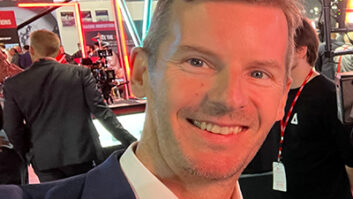One of the key moments in the history of the BBC is the first large-scale outside broadcast (OB), when it took its cameras to the Coronation of King George VI in 1937 using a mobile control van. Many other triumphs for the BBC’s Outside Broadcast Department soon followed, with the televising of the Olympic Games for the first time in 1948 and the Coronation of Queen Elizabeth II in 1953 – which crowned the 50s the ‘decade of television’. Fast forward to 1958 and Canon introduced its first broadcast lens – the IF-I 60-400mm zoom – which helped to push the landscape of outside broadcast even further, reaching previously unheard-of focal lengths.
These key milestones in outside broadcast, alongside World War II reporting, ignited a demand for dedicated news services. The BBC’s first rolling TV news service was launched in 1997 as BBC News 24. This paved the way for the future of news consumption, which is today driven by online websites, mobile apps and social media.
With a plethora of news available at our fingertips and many broadcasters competing in this space, quality and timeliness have become major focus points for Canon. Over the years, we have prioritised innovations that pushed technical boundaries and enabled broadcasters to better capture the story. With image quality at the root of what we do, this has allowed us to make the leap from black-and-white to the impeccable colour reproduction capable of our cameras now, and from SD, to HD and then on to 4K.
Since the BBC website officially launched a month after BBC News 24, we have entered a new age of television driven by the rise of on-demand streaming, which began with YouTube in 2005. The rise in streaming has meant that broadcasters and suppliers alike have had to incorporate cloud-based technologies and servers to keep up with an increased volume of content available to viewers globally, as well as higher expectations when it comes to image quality. To put into perspective how far we’ve come, BBC engineers invented the first means of recording live TV in 1947 and now, streaming services such as BBC iPlayer mean programmes are available to watch on demand as soon as they are broadcast.
During its history, the BBC has had to weather many storms, but most recently it, like other broadcasters and streaming services, had to contend with the pandemic. To keep pace with the content demand, they would have adopted remote production practices to overcome travel restrictions and the inability to work from one place. During this time, we saw the demand for PTZ cameras increase as broadcasters used them to connect remote studios with the main studio, using IP technology, and within multi-camera settings so that broadcasters could operate with streamlined crews. Their efficiency means PTZ cameras have become and will continue to be a mainstay in the broadcast industry.
Broadcasters have also started to notice the benefits of virtual and extended reality production. The use of high-resolution LED walls has become an alternative way to replicate life-like backdrops and therefore produce powerful content across a range of applications, without having to leave the studio. Over the next few years, VR production will remain high on the agenda as the industry continues to experiment with different virtual scenes while keeping travel costs low.
Streaming platforms are also exploring a range of new storytelling formats, such as interactive films and VR headsets, which will require greater agility and investment in futureproofed technologies. Broadcasters and suppliers alike will need to operate similarly and evolve their VR and Metaverse offerings to stay competitive in a content-rich world. Some broadcasters are already taking an interest in Canon’s Free Viewpoint Video System, which creates an immersive experience for viewers.
However, when it comes to competing against agile streaming platforms that have access to a global market of content creators and talent, broadcasters have a trump card – regularly scheduled sports broadcasting. This year’s FIFA World Cup has delivered record-breaking TV audience numbers, with almost 20 million Britons watching the final and BBC once again beating ITV in the ratings. It is clear that investing in futureproofed technologies that provide this high-quality content while maintaining efficient and versatile broadcast workflows will be the key to retaining viewers in the foreseeable future.







